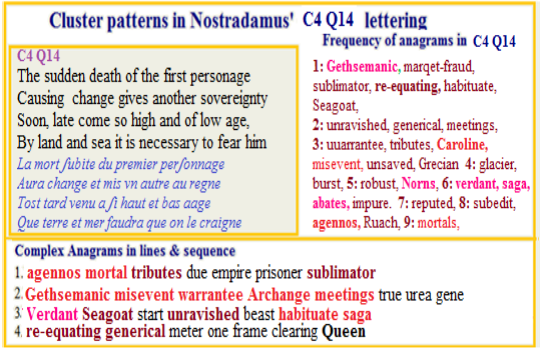 Analyses of all verses
Analyses of all verses
|
 Web Site
Web Site |
 All
Sefirots All
Sefirots |
Nostradamus C4 Q14: Melting
glaciers and celestial signs at the birth of a cloned religious leader
Copyright: Allan Webber, December 2015, 2022
 The tone of this verse suggest the beginning of a new
era in which a very young person is accepted as its leader. That person
goes on to become a major figure in a world riven by war and vast changes.
The tone of this verse suggest the beginning of a new
era in which a very young person is accepted as its leader. That person
goes on to become a major figure in a world riven by war and vast changes.
All this fits to the substance of the tales in the verses based on anagrams for agennos etc. One of the anagrams for agennos appears in the first line where it is adjacent to equally telling anagrams for mortal tributes.
Verses C10 Q65, C8 Q99 and this verse obviously relate to the same story.
In the first line of text in C10 Q65 we have ' O vast Rome, thy ruin approaches' while in the second line of C8 Q99 it says 'the sacred seat put in another place' and critically they agree on what it is that is ruined.
The second line of C10 Q65 says ' not of the walls, of thy blood and substance' and the last two lines of C8 Q99 specify 'substance of body and spirit restored and received as the true seat'.
The connection with the current verse (C4 Q14) is via its religious anagrams. The reference to Gethsemanic together with adjacent anagrams for agennos mortals are the most potent.
I choose to pair C10 Q65 and C4 Q14 because in addition the Jesus story line they share in their anagrams relates to its earliest days.
There are eight verses with an anagram of Agennos and this is one of them. These verses form a remarkable set with a strong link to Christs mortal / immortal status and his family connection to God all of which is in keeping with agennos (begotten without a father). All eight of the agennos anagram verses can be accessed through agennos quatrains
 Within the anagrams of this verse
the ones for
Gethsemanic (change et mis)
sublimator (La mort ſubit),
robust
(ort ſub),
meetings
(nge et mis), and
misevent (e et mis vn)
are either singular with no other occurrences or have a
maximum of two. Together with the adjacent anagrams for
mortal agennos (La
mort - ſonnage) they weave a tale consistent with the story of
Jesus and his disciples at the Garden of Gethsemane.
Within the anagrams of this verse
the ones for
Gethsemanic (change et mis)
sublimator (La mort ſubit),
robust
(ort ſub),
meetings
(nge et mis), and
misevent (e et mis vn)
are either singular with no other occurrences or have a
maximum of two. Together with the adjacent anagrams for
mortal agennos (La
mort - ſonnage) they weave a tale consistent with the story of
Jesus and his disciples at the Garden of Gethsemane.
This verses text can then be seen as a precise of the papal line passing from the death of Jesus up to modern times. It can also be considered as further commentary on Nostradamus' acrimonious debates over these issues with Jules Scaliger of Agen (See Jules of Agen for more).